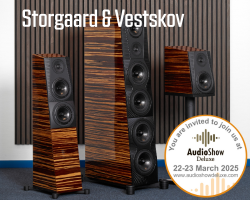The £5500 Audio Music AM RT-1 active TVC single ended valve preamplifier is made and designed by Mr A M Fang in Guangdong Province in China. It comes with a fine pedigree, but will it cut the mustard with Dan Worth.
Audio Music evolved from the Stereo Knight brand of high-end, yet relatively affordable products. Designer and engineer AM Fang wanted to create a newer more vibrant company that pushed the boundaries of design and high precision engineering even further with a line up of products to rival some of the world’s greatest talents in audio reproduction.
Previous products from the Stereo Knight range were extremely well constructed and implemented with the preamplifiers being TVC based (Transformer Volume Control), many years of creative testing also demonstrated the brands knowledge to influence the design of valve based mono power amplifiers.
Today Audio Music have continued there pursuit of musical bliss with the edition of more complex and refined preamplifiers and passives, along with some serious looking 833 and 805 based mono power amplifiers.
FIT AND FINISH
There’s no doubt that when an AM product comes for a visit the courier needs to be a fairly large chap or have a trolley handy! In the case of this review product it’s the AM RT-1, a valve based preamplifier utilising transformer volume controls in a dual mono format, with a transformer coupled output stage. The courier was not expecting the answer I gave when he said ‘my god, what on earth is in here this time Dan?’ With me replying ‘just a preamp’. The overall weight of the two units (one preamp and one power supply) is 38kgs! An absolute beast, that size wise only comes in at 38x31x11cm per unit.
Opening the boxes to get a glimpse of the two units was an unbearably exciting event. I’d studied many photographs of the preamp over the previous weekend admiring its build quality and beautifully thought out layout. To finally have the physical articles in front of me was a true joy.
The build quality is absolutely phenomenal, the attention to detail and accuracy of machining puts AM products up their with the very best that I have ever experienced in the high end world of Hifi, which is a world usually only ever inhabited by the purely unobtainable. Each panel is precisely engineered to the finest of finishes, internal boundary sections of machined billet are impressively accurate and each component and its wiring is of the neatest possible standard. Mr Fang should be truly proud of this accomplishment alone.
What are those big caps inside you say? Well, these are from a company called u-cap, not heard of them? No, nor have I. Talking to Iain Borthwick of lwaudio (UK Distributor) he relayed a short story which I would like to share – Mr Fang, the stickler for perfection that he is, decided that the capacitors on today’s market were not quite at the specification he would have truly liked, so what would any engineer/designer do in this case I ask you? They would contact one of the major brands of course and have capacitors made to their very particular specifications, surely?…. no, not Fang, he decided that along with meticulously winding his own custom transformers he would build a factory that would be able to produce capacitors to his exacting standards! Now in my mind that’s overkill to the last degree, but for Fang this is just another day at the office. The saying “if you want something done right, then do it yourself” springs to mind. I’m going to have to slightly change the initials to this mans name, AM Fang becomes AMS Fang (A Mad Scientist Fang), his efforts are pretty much unheard of today, every meticulous nut and bolt, cap, transformer, PCB layout, casing positioning is just phenomenally critiqued by Fang before us reviewers and consumers alike even get the chance to have a look. Really though, this level of attention to detail deserves applause.
Now, I hear everyone saying ‘yes, yes that’s all good and well Dan and we appreciate your candour but what does it sound like, does all the visual hype translate into equally exceptional sound quality?’
With a selection of three inputs, whether you opt for using the units assigned unbalanced XLR or unbalanced RCA inputs, a choice must be made for each of the three inputs available. My first instinct of course is to connect to the unit’s XLR inputs, but as the design is single ended and not truly balanced it shouldn’t really matter. I only have the single ended DiDiT 212 DAC at the moment as the balanced version is in final stages before production and my pre-ordered unit will not arrive for a little while yet.
The RCA version of Studio Connection’s Platinum interconnects were plugged from DAC to pre, the same brand XLRs then trailed from the AM RT-1’s balanced output sockets rather than RCA as the Muse Reference 300 monos I’m using are much more comfortable running on balanced, even if pseudo for some unknown reason. My usual modded Ayon Seagull Ceramic speakers are in play and all of this fed from the modded Mac using various software for normal and hi-res audio playback, through the recently reviewed Hydra S and Chord’s Sarum Super Aray USB.
THE SOUND
The first most clearly defined aspect of this preamp’s sound signature is true transparency, after a few steps on both mono switches whilst listening to Nils Lofgren’s ‘Keith Don’t Go’ I felt I was really hearing my system for the first time in all its natural beauty. I specifically picked this track to begin as it’s live, well recorded and needs a critical ear on leading edge performance, pace, and decay during the guitar solo off of the ‘Acoustic Live’ album.
I’ve never previously heard the decay of strings fade into such a dark background, especially on a live album so intrinsically natural, whilst the next leading edge saturates the foreground with precision and clarity. This all becomes so valuable when the wooden casket of the instrument itself can be heard as an extra resonating layer which fulfils a realism in the music, which I haven’t before heard any other preamplifier achieve in my system.
Transformer based volume controls have a nature of being transparent and great ones will produce a level of detail and timbre which can be hard to achieve from an active preamp, however they can have some pitfalls. Drive can be a little weak, also grip and control can suffer, trading these aspects slightly for natural tones and detail retrieval generally outweighs any shortfalls for most enthusiasts.
The AM RT-1 takes all of the best aspects from each of the topologies and runs with it. Transformer volume switches to improve the noise floor, a single-ended valve stage to increase dynamic range and tone and critically wound c-core transformers with mosfet voltage stabilisers for drive and grip on some of the most demanding basslines makes me wonder what on earth some are missing from their designs.
I could play bass from a passage of Bach, a track from a Damien Rice album, playful Jazz and Trad, or even Pop with a little Dance music thrown in and each time the grip drive and gusto for each music type was enthralling!
I especially loved how the influence of popular music from across the decades sounded as each track from a playlist would be discernibly different… as the playlists are from various artists. Each track had a character of its own and my own system’s signature, or house sound, disappeared and was replaced by music that had a relative tone and position with more truth to the mix. Each recording could be explored further than when using my Jeff Rowland preamps which add a characteristic warmth and body to the sound.
Equally remarkable is the soundstaging of the AM RT-1. I really appreciate how different genres are protrayed, giving a more realistic perception of a performance, especially with live music, where I felt I could place each member of the group more accurately and each band members instrument had its own void to emerge tones from that was never disjointed from the music as a whole and remained utterly focused in its own free space.
Levels of excitement built drastically over the follow weeks, where I found myself listening to music more than I had done for a long while in my own personal time. I’d find myself getting up in the mornings and listening to the main system before I left the house and likewise when I came home again, I’d even just leave everything turned on whilst I was away from home so that when I arrived back I could have a fully warmed up system to just sink into.
A strong curiosity with the AM RT-1 was, if it sounds so utterly mesmerising now, how will it sound with a careful valve change? The valve compliment used in the RT-1 is two 6922/E88CC and two 6H30P. The hunt was now on for the best sounding equivalents in this circuit. The 6H30P tubes, which are the Electro Harmonix gold pin version were swapped out for the only real possibility, the early 80’s model, legendary Russian Reflektor 6H30P-DR ‘Super Tubes’, which were incredibly hard to source and cost a small fortune. After some competition the 6922 valves I settled on were the USA made Amperex White Label, which bring a more organic flow to the mids and give a more dynamic bassline, again difficult to source and quite pricey but the way things were going with my time courting the AM RT-1 I could see us having a long and loving future together.
How gorgeously the vocals developed in tonal balance and natural dynamism after the valve upgrade left me mesmerised by every piece of music I played. I have only ever heard such fluid and liquid vocals like this once before with Lampizat0r equipment, but the AM RT-1 had no fear of breaking down and is built like a piece of fine jewellery, so in comparison its material wealth was simply greater. Coupled with the units subtle, sultry, dynamic, fast, gritty, deep and delicious characteristics that exuded from my transducers I felt very flattered to have found this brand.
There’s the cliche ‘it’s like someone has lifted a veil’. I could agree with this in terms of transparency and insight but to try and convey some more meaningful context to the sound, my analogy can only be stated as a difference between watching a high school play compared to that of a Broadway show, the raw emotion and power in the performance gives the AM RT-1 true believability.
I laughed to myself, thinking back to when the AM RT-1 first arrived some two months ago. I had just placed the units on the rug in my living room, side by side waiting for my friend Richard to come over. Richard is a DIY enthusiast and has some very interesting equipment. I knew as soon as he walked in he would just stop and look at the units then turn to me and offer that grin of acceptance he does when something pretty catches his eye. How correct I was, however I didn’t expect him to sit cross legged on the rug for a good five minutes just turning the witches backwards and forwards, but there you go. Fortunately they are of superb quality and this over exuberant wear and tear didn’t phase the solid build one little bit. He then spent the next twenty minutes along side me just glaring into the custom made and engraved acrylic lids Iain Borthwick of lwaudio had got custom made to show off all the lingerie the electronics was adorned in.
Well, Richard was here again today and we both spent some time listening through a great range of West African and Asian music which he is very fond of. It’s the first time my ever critical friend has remarked at how natural and full instruments sounded, with areas of micro dynamics which belie the very room we were listening in. I pointed out to him that centre focus was no longer as prominent and although the central soundstage was so well defined and characterised he needs to have a seat in my sweet spot to really enjoy how the stabilisation of imagery has now grown to include all areas of the soundstage in height and width, giving more maturity and insight into what is a true full picture or image of the performance, which I felt my previous preamps did well, but in hindsight barely scratched the surface and he agreed without hesitation.
Mr Fang’s meticulous approach taken to the design of his products is truly reflected in the sound of this preamplifier. I am just so impressed with the level of performance obtained at this price point. The true impact and emotion coupled with intricate detail, timing and top end air simply put, proves itself time and time again with each and every piece of music I have thrown at my system.
Every venue is accurately portrayed, each note is produced with body and the story told within each piece of music, whether containing vocals or not, is emotionally connective. I can only speculate the improvements of the models further up the line, but right here, right now the AM RT-1 is the very best (by quite a margin) preamplifier I have had the pleasure of having in my system and there is no chance of it going back to the distributor, even if it’s the only one he has in stock.
CONCLUSION
The Audio Music RT1 is an absolute giant killer in my eyes. The brand offers another two incarnations of the design which take the performance even further. Firstly an RT-2, which, is an RT-1 that has all silver wiring throughout, then the RT-3, a silver wired dual mono power supply like the previous two models but this time you will receive three boxes rather than two, with more isolation and tweaks to power sections.
Performance of the AM RT-1 is absolutely natural and emotionally engaging, having me listen to more music than I have in a few years. I currently have lots of other activities which I am enjoying in my life and finding some real solid time to just sit down and have long listening sessions has not been as easy as years gone by, but I am finding myself making time to change this and my listening sessions have been becoming more frequent since the Audio Music AM RT-1 arrived and my listening has included many albums I haven’t listened to for a very long time… as well as the enthusiasm to find and listen to new music.
The standard unit was a dream to behold, but the addition of the specially selected NOS valves really enhanced the RT1’s natural abilities to reproduce timbre and vocal complexity.
Already the soundstage was a triumph, but the additional valves made instrument placement more accurate in sense of timbre and naturalness, whilst also pushing the layering of venue acoustics and reverbs to the next level. The base unit will amaze even the most hardcore audiophile, but with these careful choices in play sonic greatness is achieved.
For my musical tastes, which are vast and varied, good solid state amplification coupled to the cleverly implemented valve line stage of the AM RT-1 suits my needs absolutely perfectly.
Sound Quality: Absolutely stunning, liquid midrange, very dynamic bass and a bandwidth that combines inner and upper end details with emotional insight and clarity.
Build Quality: Will compete with a lot high-end offerings and surpass many, absolute precision and quality inside and out, with a meticulous view on circuit and component implementation.
Value For Money: The AM RT-1 is a fairly costly preamplifier, but in the realms of high-end prices the RT1 is a bit of a bargain.
Pros:
Highly detailed natural sound
Naturally dynamic and transparent
Emotionally communicative
Timbre rich
Cons:
Only three inputs may not be enough for some
Lack of remote could be a problem for some
Price – £5500
Dan Worth
SPECIFICATIONS
Tube complement: Two 6H30 or 6H6N as the drivers, two 6922 as the amplifiers
Frequence response: 20 Hz ~ 100KHz
Input Impedance: 47k ohms variable depending on the source
Volume control: 33-speed volume control
Output Impedance: 600 ohms . RCA output & BAL output.
Input selections: 3 pairs RCA single-ended ; 3 pairs balanced / XLR
Gain: Input 0.5V output 2.5V
S / N: > 98dB
Distortion rate: Under 0.5% / 5V
Power consumption: 45 watts
Dimensions (W * D * H): 380W*340D*110H*(mm)
Weight: 38 Kg shipping weight















































































































































































You must be logged in to leave a reply.